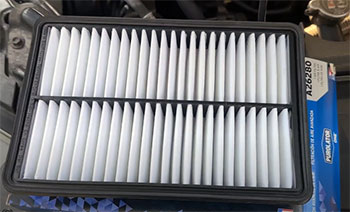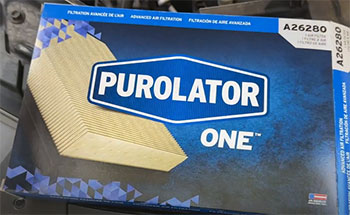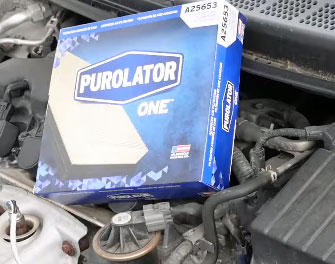I’m sold on the Purolator ONE air filter, and you should be too. After swapping out my car’s stock filter for this gem, I noticed smoother acceleration and a happier engine, all without breaking the bank.
It’s a no-brainer for anyone who wants to keep their vehicle running like a dream while dodging pricey dealership visits. In this article, I’ll walk you through my experience, break down the pros and cons, share maintenance tips, and stack it up against other brands. Trust me, this filter’s a game-changer for your ride.
My Journey With The Purolator ONE Air Filter

Let me paint you a picture. About a year ago, I was driving my 2018 Honda Accord through the bustling streets of my city, and I started noticing my car wasn’t quite itself. The acceleration felt sluggish, like my engine was gasping for air.
I popped the hood, checked the air filter, and—yep—my stock filter was a dusty, sad mess. I’d been putting off replacing it, thinking it wasn’t a big deal, but that was a mistake. A quick trip to the auto parts store later, I grabbed a Purolator ONE air filter, drawn in by its sleek blue box and bold claims of 99% filtration efficiency.
Installing it was a breeze. I’m no mechanic, but swapping out the air filter took me less than 10 minutes—no tools, no fuss. The filter fit my Accord’s airbox like a glove, with a snug polyurethane seal that made me confident no dirt was sneaking past. The first drive after the swap? Night and day. My car felt peppier, like it had shaken off a cold.
The throttle response was crisper, and I swear I could hear the engine purring with gratitude. I even tracked my fuel economy over the next few weeks, and I was getting about a mile per gallon more than before—not a huge jump, but enough to make me smile at the pump.
What really sold me was checking the filter after six months. I live in a city with plenty of dust and pollen, so I expected it to be filthy. Sure enough, it was caked with grime, which told me it was doing its job—trapping contaminants before they could gunk up my engine.
Unlike my old stock filter, which barely caught anything, the Purolator ONE was working overtime. I’ve since replaced it again, and each time, I’m impressed by how well it holds up. It’s become my go-to for keeping my car’s engine breathing easy, and I’m not looking back.
The Upsides Of The Purolator ONE Air Filter

- Stellar Filtration Performance: Let’s talk about what makes the Purolator ONE shine: its filtration game is top-notch. The filter boasts a 99% efficiency rating, which means it traps nearly all the dust, soot, and pollen trying to sneak into your engine. I noticed this firsthand when I checked my filter after a few months of city driving. It was loaded with debris, proof that it was shielding my engine from harm. That kind of protection translates to better combustion, smoother performance, and a longer life for your engine’s critical components. For someone like me, who drives through urban chaos daily, that’s peace of mind.
- Boosts Engine Efficiency: Ever feel like your car’s just not giving its all? A clogged air filter could be the culprit, choking your engine and sapping its power. The Purolator ONE’s synthetic media and precision design let air flow freely while still catching contaminants. After installing it, I felt a noticeable kick in acceleration—nothing dramatic, but enough to make merging onto highways fun again. Plus, that slight bump in fuel economy I mentioned earlier? That’s the filter helping your engine burn fuel more efficiently. It’s like giving your car a shot of espresso.
- Easy Installation for DIYers: I’m no gearhead, but I love saving a buck by doing simple maintenance myself. The Purolator ONE makes that easy. It’s designed to fit snugly in most vehicles’ airboxes, with a polyurethane frame that seals tight. I swapped mine out in under 10 minutes, no tools required—just pop open the airbox, pull out the old filter, and slide in the new one. The even pleats and sturdy construction gave me confidence it was built to last. If you’re looking to skip the dealership’s $100 labor charge, this filter’s your ticket.
- Durable and Long-Lasting: This filter’s built like a tank. The synthetic media and steel grid backing hold up under tough conditions, whether you’re cruising dusty backroads or stuck in stop-and-go traffic. I’ve gone a full year without issues, and the filter still looked solid when I replaced it. Purolator claims it protects for up to 12,000 miles or 12 months, and my experience backs that up. For most drivers, that means you’re set for a year of worry-free performance, which is a win in my book.
Read More: My Thoughts on Olympic Elite Stain And Sealant Reviews.
The Downsides Of The Purolator ONE Air Filter

- Fitment Issues in Some Vehicles: Not every experience with the Purolator ONE is flawless. I’ve heard from other drivers—and seen online chatter—about fitment problems with certain car models. For instance, a friend with a newer Honda Accord Hybrid tried installing one, only to find the filter was slightly too large for the airbox. It wasn’t a dealbreaker, but it meant extra effort to make it fit or returning it for a different brand. My Accord had no issues, but it’s worth double-checking compatibility for your specific vehicle before buying.
- Potential for Reduced Fuel Economy: Here’s a weird one: some drivers, including a few on forums I follow, reported a slight drop in fuel economy after switching to the Purolator ONE. I didn’t experience this—my mileage improved—but it seems the filter’s dense media can be a bit restrictive in smaller engines or cars that don’t need as much airflow. If you drive a compact car, you might want to monitor your MPG after installing it. For me, the trade-off of better filtration was worth it, but it’s something to keep in mind.
- Premium Price Point: The Purolator ONE isn’t the cheapest filter out there. It typically costs a few bucks more than basic paper filters or budget brands like Fram’s Extra Guard. I paid about $15 for mine, which felt reasonable for the quality, but if you’re pinching pennies, it might sting compared to a $10 generic option. That said, I think the extra cost is justified by the performance and durability, especially if you want to avoid engine wear in the long run.
Maintenance Tips for Your Purolator ONE Air Filter

- Check It Regularly: You don’t want to wait until your engine’s choking to inspect your air filter. I make a habit of checking mine every six months, especially since I drive in a dusty city. Just pop open the airbox—it’s usually held by clips or screws—and take a peek. If the filter’s dark with dirt or debris, it’s time to replace it. Even if it looks okay, give it a gentle tap to knock off loose dust. This simple step keeps your engine breathing easy and saves you from premature wear.
- Replace on Schedule: Purolator recommends swapping out the ONE air filter every 12 months or 12,000 miles, whichever comes first. I stick to this religiously, as it’s a small price to pay for engine health. If you drive in harsh conditions—think dusty rural roads or heavy traffic—you might need to replace it sooner, maybe every 8,000 miles. I mark my calendar for a yearly swap, and it’s become as routine as changing my oil. Trust me, your engine will thank you.
- Keep the Airbox Clean: Your air filter lives in an airbox, and that box can get grimy. Before installing a new Purolator ONE, I always wipe down the airbox with a damp cloth to clear out dust or leaves. It only takes a minute, but it ensures the filter’s working with a clean slate. Also, check the airbox clips or screws for wear—loose fittings can let unfiltered air sneak in, defeating the filter’s purpose. A clean, secure airbox is your filter’s best friend.
- Monitor Performance: Pay attention to how your car feels after installing the filter. If you notice sluggish acceleration or a drop in fuel economy, it could be a sign the filter’s too restrictive for your engine or wasn’t installed correctly. I keep a small notebook in my glovebox to jot down MPG and any odd performance quirks. It helped me confirm the Purolator ONE was boosting my efficiency, but it’s also a good way to catch issues early. Stay proactive, and you’ll keep your ride in top shape.
Comparing The Purolator ONE To Other Brands

- Wix Air Filters: Wix is a heavy hitter in the air filter world, and I’ve used their filters on an older car before switching to Purolator. Wix filters are known for their high-quality cellulose media and solid construction, often matching the Purolator ONE’s 99% filtration efficiency. I found Wix filters to be slightly less restrictive, which gave my old sedan a bit more pep. However, they’re pricier—often $18 or more—and I noticed the rubber gasket wasn’t as thick as Purolator’s, which made me question the seal in dusty conditions. Wix is a great choice, but I prefer the Purolator ONE for its balance of cost and durability.
- K&N Performance Filters: K&N’s washable, reusable filters are the darlings of performance enthusiasts, and I gave one a spin on a friend’s Mustang. They’re designed for high airflow, which can boost horsepower, but that comes at a cost: filtration isn’t as tight as the Purolator ONE’s. K&N’s oiled media can also foul sensors if over-oiled, which is a hassle I didn’t want to deal with. Plus, they’re expensive—think $50 or more—and require regular cleaning. For daily drivers like me, the Purolator ONE’s simplicity and superior contaminant protection make it a better fit.
- Fram Extra Guard: Fram’s Extra Guard is the budget king, and I’ve used it in a pinch when cash was tight. It’s dirt cheap—often under $10—but you get what you pay for. The paper media and flimsier construction don’t hold up as well, and I noticed more dust sneaking past compared to the Purolator ONE. Fram claims decent filtration, but it’s closer to 98%, not the 99% Purolator boasts. If you’re just looking to get by, Fram’s fine, but I’d rather spend a bit more for the Purolator ONE’s reliability.
- Bosch Workshop Filters: Bosch’s Workshop line is a solid middle-ground option, and I tried one on a rental car during a long road trip. They’re built to OEM specs with cellulose media and offer 98% filtration efficiency. The fit was perfect, and I liked the sturdy polyurethane seal, but the filter felt less robust than the Purolator ONE’s synthetic media. Bosch filters are priced similarly to Purolator, around $15, but I found they didn’t trap as much debris in heavy dust. For everyday driving, Bosch is reliable, but Purolator edges it out for tougher conditions.
Also read: My Thoughts on Meguiar’s Hyper Wash Reviews.
Frequently Asked Questions (FAQ)
I’d give Purolator filters a solid thumbs-up for quality. The Purolator ONE, in particular, uses synthetic media and a steel grid for durability, and its 99% filtration efficiency is no joke—I’ve seen it trap tons of dust in my own car. While there’ve been occasional reports of fitment issues or media tearing in older models, my experience has been rock-solid, and the brand’s reputation in the auto industry backs that up. For the price, you’re getting a filter that rivals or beats many competitors.
Purolator’s cabin air filters, like their ONE line, are pretty darn good. I haven’t used their cabin filter myself, but friends who have say they keep car interiors fresh by blocking pollen and dust effectively. The construction mirrors their engine filters—think sturdy media and tight seals. That said, I’ve read about fitment issues with some models, like certain Honda Hybrids, so check compatibility. If it fits, you’re getting a reliable filter that’ll keep your AC smelling clean.
The PurolatorONE is the premium choice, designed for drivers like me who want top-tier filtration—99% efficiency with synthetic media—and better airflow for performance. It’s built tougher, with steel backing, and lasts up to 12,000 miles. PurolatorTECH, on the other hand, is more budget-friendly, aimed at routine maintenance with 98% efficiency and cellulose media. It’s great for service shops or casual drivers but doesn’t match the ONE’s durability or filtration in harsh conditions. Pick ONE for demanding drives, TECH for basic needs.
Purolator says the ONE air filter lasts up to 12 months or 12,000 miles, and I’ve found that holds true. In my city driving, I replace mine yearly, and it’s always loaded with dirt by then, showing it’s doing its job. If you’re in dusty areas or drive a lot, you might need to swap it out closer to 8,000 miles. Check it every six months to be safe—your engine’s health depends on it.
Final Thoughts
You can’t go wrong with the Purolator ONE air filter. It’s a small investment that delivers big—smoother drives, better fuel economy, and an engine that stays cleaner longer. My experience with it has been nothing short of awesome, and I’m confident it’ll keep your car humming happily too. Don’t let a clogged filter hold you back; grab a Purolator ONE and feel the difference. Your engine deserves it, and so do you.
